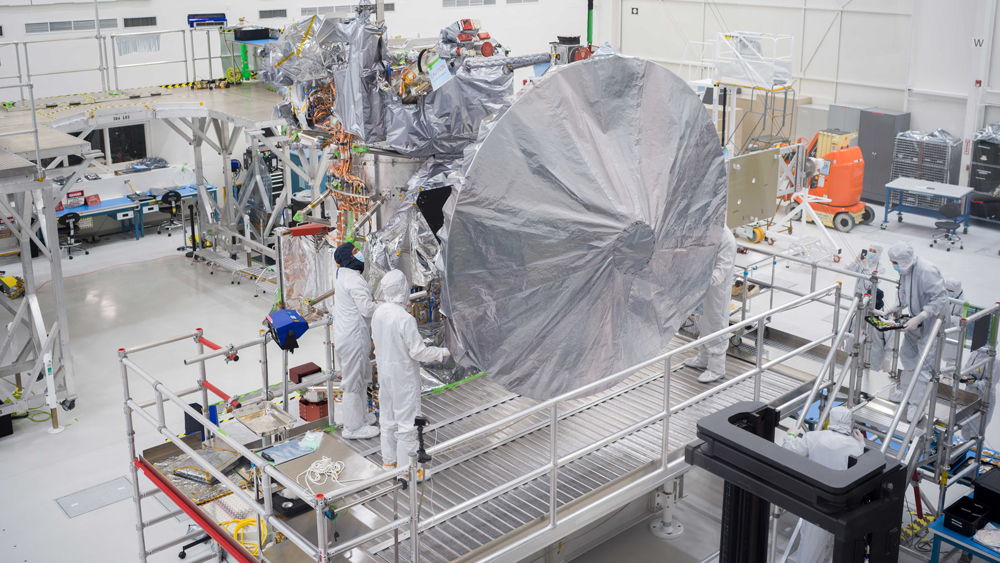
NASA’s Europa Clipper is designed to seek out conditions suitable for life on an ice-covered moon of Jupiter. On Aug. 14, the spacecraft received a piece of hardware central to that quest: the massive dish-shaped high-gain antenna.
Stretching 10 feet (3 meters) across the spacecraft’s body, the high-gain antenna is the largest and most prominent of a suite of antennas on Europa Clipper. The spacecraft will need it as it investigates the ice-cloaked moon that it’s named after, Europa, some 444 million miles (715 million kilometers) from Earth. A major mission goal is to learn more about the moon’s subsurface ocean, which might harbor a habitable environment.
Once the spacecraft reaches Jupiter, the antenna’s radio beam will be narrowly directed toward Earth. Creating that narrow, concentrated beam is what high-gain antennas are all about. The name refers to the antenna’s ability to focus power, allowing the spacecraft to transmit high-powered signals back to NASA’s Deep Space Network on Earth. That will mean a torrent of science data at a high rate of transmission.

The precision-engineered dish was attached to the spacecraft in carefully choreographed stages over the course of several hours in a Spacecraft Assembly Facility bay at NASA’s Jet Propulsion Laboratory in Southern California. “The antenna has successfully completed all of its stand-alone testing,” said Matthew Bray a few days before the antenna was installed. “As the spacecraft completes its final testing, radio signals will be looped back through the antenna via a special cap, verifying that the telecom signal paths are functional.”
Based at the Johns Hopkins University Applied Physics Laboratory in Laurel, Maryland, Bray is the designer and lead engineer for the high-gain antenna, which he began working on 2014. It’s been quite a journey for Bray, and for the antenna.
Just over the past year, he’s seen the antenna crisscross the country in the lead-up to the installation. Its ability to beam data precisely was tested twice in 2022 at NASA’s Langley Research Center in Hampton, Virginia. Between those two visits, the antenna made a stop at NASA’s Goddard Space Flight Center in Greenbelt, Maryland, for vibration and thermal vacuum testing to see if it could handle the shaking of launch and the extreme temperatures of outer space.
Then it was on to JPL in October 2022 for installation on the spacecraft in preparation for shipment next year to NASA’s Kennedy Space Center in Florida.
The long journey to Jupiter begins with launch from Kennedy in October 2024.
Europa in Their Sights
“The high-gain antenna is a critical piece in the buildup of Europa Clipper,” said Jordan Evans, the Clipper project manager at JPL. “It represents a very visible piece of hardware that provides the capability that the spacecraft needs to send the science data back from Europa. Not only does it look like a spacecraft now that it has the big antenna, but it’s ready for its upcoming critical tests as we progress towards launch.”
The spacecraft will train nine science instruments on Europa, all producing large amounts of rich data: high-resolution color and stereo images to study its geology and surface; thermal images in infrared light to find warmer areas where water could be near the surface; reflected infrared light to map ices, salts, and organics; and ultraviolet light readings to help determine the makeup of atmospheric gases and surface materials.
Clipper will bounce ice-penetrating radar off the subsurface ocean to determine its depth, as well as the thickness of the ice crust above it. A magnetometer will measure the moon’s magnetic field to confirm the deep ocean’s existence and the thickness of the ice.
The high-gain antenna will stream most of that data back to Earth over the course of 33 to 52 minutes. The strength of the signal and the amount of data it can send at one time will be far greater than that of NASA’s Galileo probe, which ended its eight-year Jupiter mission in 2003.
On site at JPL for the antenna installation was Simmie Berman, the radio frequency module manager at APL. Like Bray, she began her work on the antenna in 2014. The radio frequency module includes the spacecraft’s entire telecommunications subsystem and a total of seven antennas, the high-gain among them. Her job during installation was to ensure the antenna was properly mounted to the spacecraft and that the components are correctly oriented and well integrated.
While the engineers at both APL and JPL have practiced the installation many times, virtually and with real-world mock-ups, Aug. 14 was the first time the high-gain antenna was attached to the spacecraft.
“I’ve never worked on anything of this magnitude, in terms of physical size and also in terms of just general interest,” she said. “Little kids know where Jupiter is. They know what Europa looks like. It’s supercool to get to work on something that has the potential for such a big impact, in terms of knowledge, for humanity.”
After completing this major milestone, Europa Clipper still has a few more steps and a few more tests ahead as it’s prepared for its trip to the outer solar system.
More About the Mission
Europa Clipper’s main science goal is to determine whether there are places below Jupiter’s icy moon, Europa, that could support life. The mission’s three main science objectives are to determine the thickness of the moon’s icy shell and its surface interactions with the ocean below, to investigate its composition, and to characterize its geology. The mission’s detailed exploration of Europa will help scientists better understand the astrobiological potential for habitable worlds beyond our planet.”
News Media Contacts
Gretchen McCartney
Jet Propulsion Laboratory, Pasadena, Calif.
818-393-6215
gretchen.p.mccartney@jpl.nasa.gov
Karen Fox / Alana Johnson
NASA Headquarters, Washington
301-286-6284 / 202-358-1501
karen.c.fox@nasa.gov / alana.r.johnson@nasa.gov
Written by Pat Brennan


